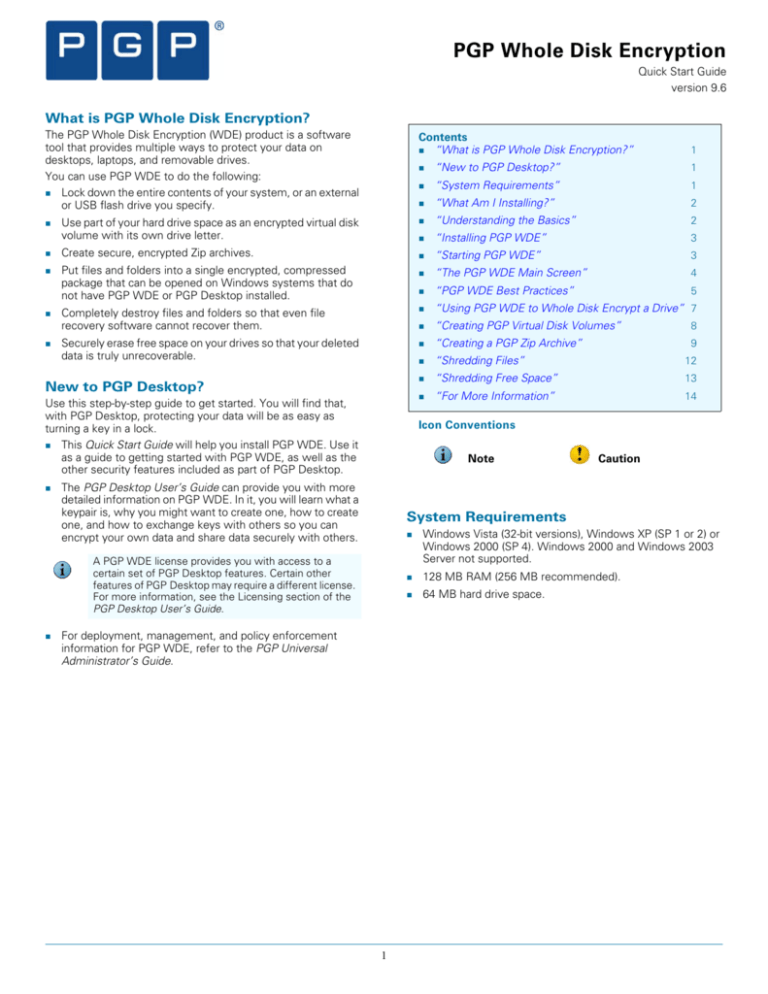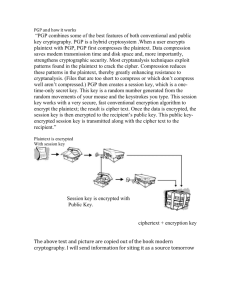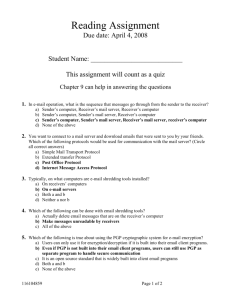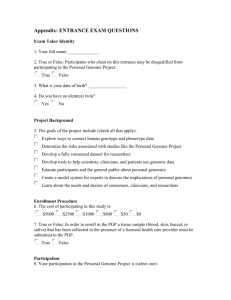
PGP Whole Disk Encryption
Quick Start Guide
version 9.6
What is PGP Whole Disk Encryption?
The PGP Whole Disk Encryption (WDE) product is a software
tool that provides multiple ways to protect your data on
desktops, laptops, and removable drives.
You can use PGP WDE to do the following:
Lock down the entire contents of your system, or an external
or USB flash drive you specify.
“New to PGP Desktop?”
1
“System Requirements”
1
“What Am I Installing?”
2
“Understanding the Basics”
2
“Installing PGP WDE”
3
“Starting PGP WDE”
3
“The PGP WDE Main Screen”
4
“PGP WDE Best Practices”
5
Completely destroy files and folders so that even file
recovery software cannot recover them.
“Using PGP WDE to Whole Disk Encrypt a Drive” 7
“Creating PGP Virtual Disk Volumes”
Securely erase free space on your drives so that your deleted
data is truly unrecoverable.
“Creating a PGP Zip Archive”
“Shredding Files”
12
“Shredding Free Space”
13
“For More Information”
14
Use part of your hard drive space as an encrypted virtual disk
volume with its own drive letter.
Create secure, encrypted Zip archives.
Put files and folders into a single encrypted, compressed
package that can be opened on Windows systems that do
not have PGP WDE or PGP Desktop installed.
New to PGP Desktop?
Use this step-by-step guide to get started. You will find that,
with PGP Desktop, protecting your data will be as easy as
turning a key in a lock.
This Quick Start Guide will help you install PGP WDE. Use it
as a guide to getting started with PGP WDE, as well as the
other security features included as part of PGP Desktop.
Note
1
Contents
“What is PGP Whole Disk Encryption?”
8
9
Icon Conventions
Note
The PGP Desktop User’s Guide can provide you with more
detailed information on PGP WDE. In it, you will learn what a
keypair is, why you might want to create one, how to create
one, and how to exchange keys with others so you can
encrypt your own data and share data securely with others.
Caution
System Requirements
A PGP WDE license provides you with access to a
certain set of PGP Desktop features. Certain other
features of PGP Desktop may require a different license.
For more information, see the Licensing section of the
PGP Desktop User’s Guide.
For deployment, management, and policy enforcement
information for PGP WDE, refer to the PGP Universal
Administrator’s Guide.
1
Windows Vista (32-bit versions), Windows XP (SP 1 or 2) or
Windows 2000 (SP 4). Windows 2000 and Windows 2003
Server not supported.
128 MB RAM (256 MB recommended).
64 MB hard drive space.
What Am I Installing?
PGP Desktop uses licensing to provide access to the features you purchase. Depending on the license you have, some or all of the PGP
Desktop family of applications will be active.
This document contains instructions for viewing the features activated by your license.
PGP Whole Disk Encryption (WDE) is a member of the PGP Desktop family of applications. You can use PGP WDE to
lock down the entire contents of your system or an external or USB flash drive you specify. Boot sectors, system files,
and swap files are all encrypted. Whole disk encrypting your boot drive means you do not have to worry if your computer
is lost or stolen: to access your data, an attacker would need to know your passphrase.
Other components of PGP Desktop that are included with PGP WDE:
PGP Virtual Disk volumes — Uses part of your hard drive space as an encrypted virtual disk volume with its own drive
letter. You can create additional users for a volume so that people you authorize can also access the volume. A
PGP Virtual Disk is the perfect place for storing your sensitive files; it is as if you have stored them in a safe. When the
door of the safe is open (when the volume is mounted), you can change files stored in it, take files out of it, and move
files into it. Otherwise (when the volume is unmounted), all the data on the volume is protected.
PGP Zip — Adds any combination of files and folders to an encrypted, compressed, portable archive. PGP WDE or
PGP Desktop must be installed on a system to create or open a PGP Zip archive. PGP Zip is a tool for securely archiving
your sensitive data, whether you want to distribute it to others or back it up.
PGP Self-Decrypting Archives (SDAs) — Puts files and folders into an encrypted, compressed package that can be
opened on a Windows system that does not have PGP WDE or PGP Desktop installed. SDAs are the perfect solution for
securely exchanging files with someone who does not have PGP software installed.
PGP Shredder — Completely destroys files and folders so that even file recovery software cannot recover them. Deleting
a file using the Windows Recycle Bin does not actually delete it; it sits on your drive and eventually gets overwritten. Until
then, it is trivial for an attacker to recover that file. PGP Shredder, in contrast, immediately overwrites files multiple times.
This is so effective that even sophisticated disk recovery software cannot recover these files. This feature also
completely wipes free space on your drives so your deleted data is truly unrecoverable.
Key Management— PGP WDE also manages PGP keys, both your keypairs and the public keys of others. You use your
private key to decrypt messages sent to you encrypted to your public key and to secure your PGP Virtual Disk volumes.
You use public keys to encrypt messages to others or to add users to PGP Virtual Disk volumes.
Understanding the Basics
After installation, PGP WDE prompts you to create a
PGP keypair. A keypair is the combination of a private key and a
public key.
Keep your private key and its passphrase private, as the
name suggests. If someone gets your private key and its
passphrase, they can read your messages and impersonate
you to others. Your private key decrypts incoming encrypted
messages and signs outgoing messages.
Your public key you can give to everyone. It does not have
a passphrase. Your public key encrypts messages that only
your private key can decrypt and verifies your signed
messages.
1
Your keyring holds both your keypairs and the public keys of
others, which you use to send encrypted messages to them.
Click the PGP Keys Control Box to see the keys on your keyring:
1 The icon for a PGP keypair has two keys, denoting the
private and the public key. Alice Cameron has a PGP keypair
in this illustration, for example.
2
2 The icons for the public keys of others have just one key.
Ming Pa’s public key, for example, has been added to the
keyring shown in this illustration.
2
Installing PGP WDE
The installation process requires a system restart.
PGP Corporation recommends exiting from open applications before you begin the install.
Depending on your license, you may not have access to certain components of PGP Desktop.
Note
To install PGP WDE:
1 Locate the PGP WDE installer program.
3 Follow the on-screen instructions.
4 Reboot your system when instructed.
The installer program may have been distributed by your
PGP administrator using the Microsoft SMS deployment
tool.
5 When your system restarts, follow the on-screen
instructions to configure PGP WDE.
2 Double-click the installer.
Note
To see what features your PGP Desktop license supports, open PGP WDE and from the Help menu, select
License. Those features with a green checkmark are supported by the active license. In this illustration,
PGP Whole Disk Encryption, PGP Zip, and PGP Virtual Disk are supported.
Starting PGP WDE
To start PGP WDE, use any of the following methods:
Double-click the PGP Tray icon.
Right-click the PGP Tray icon, and then select
Open PGP Desktop.
From the Start menu, select Programs > PGP >
PGP Desktop.
PGP Tray icon.
3
The PGP WDE Main Screen
The easiest way to access the features of PGP WDE is via its main screen.
11 PGP Menu bar — Provides access to all PGP WDE features through its menus and commands.
22 PGP Toolbar — Provides access to several commonly performed PGP WDE tasks.
3
Work Area — You configure the settings for the active feature in the work area.
This illustration shows the PGP WDE work area.
1
2
4
5
6
7
3
8
4
PGP Keys Control Box — Controls your PGP keys.
5
PGP Messaging Control Box — Controls PGP Messaging.
6
PGP Zip Control Box — Controls PGP Zip archives.
7
PGP Disk Control Box — Controls PGP Virtual Disk volumes and PGP Whole Disk Encrypted drives.
8
PGP NetShare Control Box — Controls PGP NetShare.
4
PGP WDE Best Practices
PGP Corporation recommends the following best practices for preparing to encrypt your disk. Please follow the recommendations below
to protect your data during and after encryption.
Before you encrypt your disk, there are a few tasks you must perform to ensure successful initial encryption of the disk.
5 Be certain that you will have AC power for the duration of
the encryption process. See Maintain Power Throughout
Encryption on page 6.
1 Determine whether your target disk is supported. PGP
WDE feature protects desktop or laptop disks (either
partitions, or the entire disk), external disks, and USB flash
disks. CD-RW/DVD-RWs and servers are NOT supported.
See Chapter 6 of the PGP Desktop User’s Guide for more
details on what types of disks are supported.
6 Run a pilot test to ensure software compatibility. As a
good security practice, PGP Corporation recommends
testing PGP WDE on a small group of computers to ensure
that PGP WDE is not in conflict with any software on the
computer before rolling it out to a large number of
computers. This is particularly useful in environments that
use a standardized Corporate Operating Environment (COE)
image. For a list of software known to have compatibility
issues with PGP WDE, see Run a Pilot Test to Ensure
Software Compatibility on page 6.
2 Back up the disk before you encrypt it. Before you encrypt
your disk, be sure to back it up so that you won’t lose any
data if your laptop or computer is lost, stolen, or you are
unable to decrypt the disk.
3 Ensure the health of the disk before you encrypt it. If PGP
WDE encounters disk errors during encryption, it will pause
encryption so you can repair the disk errors. However, it is
more efficient to repair errors before you initiate encryption.
See “Ensure Disk Health Before Encryption” for more
information.
7 Perform Disk Recovery on Decrypted Disks. Where
possible, as a best practice, if you need to perform any disk
recovery activities on a disk protected with PGP Whole Disk
Encryption (WDE), PGP Corporation recommends that you
first decrypt the disk. Do this by using the PGP Desktop
Disk > Decrypt option, your prepared PGP WDE Recovery
Disk, or by connecting the hard disk via a USB cable to a
second system and decrypting from that system's PGP
Desktop software. Once the disk is decrypted, proceed with
your recovery activities.
4 Create a recovery disk. While the chances are extremely
low that a master boot record could become corrupt on a
boot disk or partition protected by PGP Whole Disk
Encryption, it is possible. Before you encrypt a boot disk or
partition using PGP Whole Disk Encryption, create a recovery
disk. See “Create a Recovery CD” for instructions on how
to create a recovery disk.
Ensure Disk Health Before Encryption
PGP Corporation deliberately takes a conservative stance when
encrypting drives, to prevent loss of data. It is not uncommon to
encounter Cyclic Redundancy Check (CRC) errors while
encrypting a hard disk. If PGP WDE encounters a hard drive or
partition with bad sectors, PGP WDE will, by default, pause the
encryption process. This pause allows you to remedy the
problem before continuing with the encryption process, thus
avoiding potential disk corruption and lost data.
To avoid disruption during encryption, PGP Corporation
recommends that you start with a healthy disk by correcting any
disk errors prior to encrypting.
Before you attempt to use PGP WDE, use a third-party scan
disk utility that has the ability to perform a low-level integrity
check and repair any inconsistencies with the drive that
could lead to CRC errors. Microsoft Windows' check disk
(chkdsk.exe) utility is not sufficient for detecting these
issues on the target hard drive. Instead, use software such
as SpinRite or Norton Disk DoctorTM. These software
applications can correct errors that would otherwise disrupt
encryption.
As a best practice, highly fragmented disks should be
defragmented before you attempt to encrypt them.
Create a Recovery CD
7 Insert a blank, recordable CD into a CD drive on your system.
The following instructions use Roxio software for illustration
purposes. The actual steps you perform may differ.
1 Make sure PGP Desktop for Windows and Roxio Easy Media
Creator or Roxio Easy CD Creator (or other software that can
create a CD from an ISO image) are installed on your system.
8 On the Record CD Setup screen, click Start Recording.
9 When the file is burned to the CD, click OK.
10 Remove the recovery CD from the drive and label it
appropriately.
2 Open Roxio Easy Media Creator or Roxio Easy CD Creator
and choose to create a Data CD Project.
3 From the File menu, select Record CD from CD Image.
Caution
4 From the Files of Type menu, select ISO Image Files (ISO).
5 Navigate to the PGP directory. The default is: C:\Program
Files\PGP Corporation\PGP Desktop\.
6 Select bootg.iso and click Open.
5
PGP WDE recovery disks are compatible only with the
version of PGP Desktop that created the recovery CD. For
example, if you attempt to use a 9.0.x recovery disk to
decrypt a disk protected with PGP WDE 9.6 software, it will
render the PGP WDE 9.6 disk inoperable.
PGP WDE Best Practices (continued)
Maintain Power Throughout Encryption
Do not remove the power cord from the system before the
encryption process is over. If loss of power during encryption is
a possibility—or if you do not have an uninterruptible power
supply for your computer—consider choosing the Power
Failure Safety option, as described in the PGP Desktop User’s
Guide.
Because encryption is a CPU-intensive process, encryption
cannot begin on a laptop computer that is running on battery
power. The computer must be on AC power. If a laptop
computer goes on battery power during the initial encryption
process (or a later decryption or re-encryption process) PGP
WDE pauses its activity. When you restore AC power, the
encryption, decryption, or re-encryption process resumes
automatically.
Regardless of the type of computer you are working with, your
system must not lose power, or otherwise shut down
unexpectedly, during the encryption process, unless you have
selected the Power Failure Safety option.
This holds true for removable disks, such as USB devices.
Unless you have selected the Power Failure Safety option,
you run the risk of corrupting the device if you remove it
during encryption.
Caution
Run a Pilot Test to Ensure Software Compatibility
Certain other disk protection software is incompatible with PGP
WDE and can cause serious disk problems, up to and including
loss of data.
Please note the following known interoperability issues, and
please review the PGP Desktop Release Notes for the latest
updates to this list.
Software that is not compatible:
CompuTrace in MBR mode. PGP Whole Disk Encryption is
compatible only with the BIOS configuration of Absolute
Software's CompuTrace laptop security and tracking
product. Using CompuTrace in MBR mode is not compatible.
Utimaco Safeguard Easy 3.x is incompatible with the PGP
Whole Disk Encryption feature; do not install it on a system
with PGP Desktop and do not install PGP Desktop on a
system with Utimaco Safeguard Easy 3.x.
Hard disk encryption products from GuardianEdge
Technologies: Encryption Anywhere Hard Disk and
Encryption Plus Hard Disk products, formerly known as PC
Guardian products.
The following programs will co-exist with PGP Desktop on the
same system, but will block the PGP Whole Disk Encryption
feature:
Safeboot Solo
6
SecureStar SCPP
Pointsec.
Using PGP WDE to Whole Disk Encrypt a Drive
The PGP WDE feature locks down the entire contents of your system or an external or USB flash drive you specify.
PGP Corporation recommends, as a best practice, that you back up your data before encrypting your disk.
Caution
1 Click Encrypt Whole Disk in the PGP Disk
Control box.
1
2 Select the drive or partition to be encrypted.
3 Select Maximum CPU Usage to protect
your disk as quickly as possible. The
encryption process will take priority over
other operations on your system.
7
4 Select Power Failure Safety if you think
your system could lose power during the
encryption process.
3
2
When Power Failure Safety is selected, the
encryption process can safely resume if it is
interrupted. This option can cause
encryption to take longer to complete.
4
5 Click Add User Key to add users who will be
able to authenticate to the whole disk
encrypted drive using public-key
cryptography.
5
6
If you are encrypting a fixed drive, you can
only use a PGP keypair on an Aladdin eToken
USB token. If you are encrypting a partition
or a removable (non-fixed) drive, you can use
any keypair on your system.
6 Click New Passphrase User to add users
who authenticate using a passphrase.
If you are encrypting your boot drive, you
have the option of using your Windows
logon passphrase so that you only have to
enter your credentials once on startup.
7 Click Encrypt.
Note
Note
The encryption algorithm used by PGP WDE is AES256. The hashing algorithm is SHA-1. FAT16, FAT32,
and NTFS formatted drives are supported. There is no minimum or maximum size. If the drive is supported
by the operating system (or your hardware BIOS for the boot drive), it should work with PGP WDE.
To encrypt data on floppy disks or CD-RWs, use PGP Virtual Disk volumes; do not use PGP WDE.
Backup software works normally with PGP WDE; any files the software backs up will be decrypted before
being backed up.
7
Creating PGP Virtual Disk Volumes
The PGP Virtual Disk Volumes feature uses part of your hard drive space as an encrypted virtual disk volume with its own drive letter.
You can create additional users for a volume so that people you authorize can also access the volume.
1 Click New Virtual Disk in the PGP Disk
Control box.
1
2 Type a Name for the volume.
3 Specify a Disk File Location for the volume.
4 Select your mount preferences:
select a drive letter for the volume to Mount
as.
select Mount at Startup to have your new
volume mount automatically at startup.
select Unmount when inactive for x mins
to have the volume automatically unmount
when it has been inactive for the specified
number of minutes.
9
2
3
4
5
6
5 From Capacity, select Dynamic (resizeable) if
you want the volume to grow in size as you add
files or Fixed size if you want the volume to
always remain the same size.
7
8
6 Specify a filesystem Format for the volume.
7 Specify an Encryption algorithm for the volume.
8 Click Add User Key to add users who
authenticate using public-key cryptography or
click New Passphrase User to add users who
authenticate using passphrases.
9 Click Create.
Use the User Access section to control existing
users of a PGP Virtual Disk volume:
1 Click Add User Key to add users who
authenticate using public-key cryptography.
1
2 Click New Passphrase User to add users who
authenticate using passphrases.
2
3
3 Select a passphrase user, then click Change
Passphrase to change their passphrase.
4
4 Select a user, then click Make Admin to give
the user administrative rights.
5
5 Select a user, then click Delete to delete the
user.
8
Creating a PGP Zip Archive
PGP Zip archives let you put any combination of files and folders into a compressed, portable archive. There are four kinds of PGP Zip
archives:
•
Recipient keys. Encrypts the archive to public keys. Only the holder of the corresponding private keys can open the archive. This is
the most secure kind of PGP Zip archive. Recipients must be using PGP WDE or PGP Desktop for Windows.
•
Passphrase. Encrypts the archive to a passphrase, which must be communicated to the recipients. Recipients must be using
PGP WDE or PGP Desktop for Windows.
•
PGP Self-Decrypting Archive. Encrypts the archive to a passphrase, but recipients do not need to be using PGP WDE or
PGP Desktop for Windows to open it. The passphrase must be communicated to the recipients.
•
Sign only. Signs the archive but does not encrypt it, allowing you to prove you are the sender. Recipients must be using PGP WDE
or PGP Desktop for Windows to open and verify the archive.
The Passphrase and Sign only PGP Zip types are described in detail in the PGP Desktop User’s Guide; they are described briefly here.
1 Click New PGP Zip in the PGP Zip Control Box.
1
2 Drag and drop the files/folders you want to be in
the archive or use the buttons to select them.
3 Select Send original files to PGP Shredder
when finished if you want the files/folders you
put into the archive to be shredded when the
archive is created.
2
3
4 Click Next.
4
5 Select the desired kind of PGP Zip archive:
Recipient keys
Passphrase
PGP Self-Decrypting Archive
Sign only
5
6 Click Next.
Passphrase and Sign only are described in detail in
the PGP Desktop User’s Guide.
Refer to the appropriate section on the following
pages for the kind of PGP Zip archive you specified.
6
9
Creating a PGP Zip Archive (continued)
Recipient Keys
The Add User Keys screen appears.
1
1 Click Add and use the User Selection screen to
select the public keys of those persons who you
want to be able to open the archive
If you want to be able to open the archive
yourself, be sure to include your public key.
2 Click Next.
2
3 Choose a private key on the local system to use
to sign the archive.
4 Specify a name and a location for the archive.
The default name is the name of the first file or
folder in the archive; the default location is the
location of the files/folders going into the archive.
3
5 Click Next.
4
The PGP Zip archive is created.
The Finished screen displays information about
the new archive.
5
6 Click Finish.
Note
Note
The Passphrase type of PGP Zip archive
is very similar to Recipient Keys, the
difference being that a passphrase is used
to protect the archive instead of a key.
The Sign only type of PGP Zip archive is
similar to Recipient Keys, the difference
being that because the archive is only
signed, not encrypted, you do not select
public keys.
6
10
Creating a PGP Zip Archive (continued)
PGP Self-Decrypting Archive
The Create a passphrase screen appears.
1 Enter a passphrase for the PGP Zip
Self-Decrypting Archive (SDA), then confirm the
passphrase by entering it again.
1
2 Click Next.
2
3 Choose a private key on the local system to use
to sign the archive.
4 Specify a name and a location for the archive.
The default name is the name of the first file or
folder in the archive; the default location is the
location of the files/folders going into the archive.
3
4
5 Click Next.
The PGP SDA is created.
5
6 Click Finish.
6
11
Shredding Files
The PGP Shredder feature completely destroys files and folders so that even sophisticated file recovery software cannot recover them.
While both the PGP Shredder icon and the Windows Recycle Bin appear on your desktop, only PGP Shredder immediately overwrites
the files you specify so that they are not recoverable.
You can shred files using any of the following methods:
Using the PGP Shredder icon.
Using the PGP Toolbar.
Using the PGP Context menu.
Using the PGP Shredder Icon
Using the PGP Context Menu
To shred files using the PGP Shredder icon:
1 On your Windows desktop, drag the files and folders
you want to shred into the PGP Shredder.
To shred files in Windows Explorer:
1 Open Windows Explorer.
2 Right-click on the files or folders you want to shred, then
select PGP Desktop > PGP Shred <filename>.
A dialog appears, asking you to confirm you want to shred
the files.
You can Control-click to select multiple files or Control-A to
select all files showing.
2 Click Yes.
If you selected more than one file, the text says PGP Shred
x items, where x is the number of files selected.
The specified files and folders are shredded.
A dialog appears, asking you to confirm you want to shred
the files.
3 Click Yes.
The specified files and folders are shredded.
Using the PGP Toolbar
To shred files using the PGP Toolbar:
1 Click Shred Files on the PGP Toolbar.
2 Specify which files you want to shred.
You can Control-click to select multiple files or Control-A to
select all files showing.
3 Click Open.
A dialog appears, asking you to confirm you want to shred
the files.
4 Click Yes.
The specified files and folders are shredded.
Note
Note
If you do not use the PGP Shredder feature often, you can remove the PGP Shredder icon from your
desktop via PGP Options: access the Options panel, click on the Disk tab, deselect the Place
PGP Shredder icon on the desktop option, then click OK.
You can also use PGP Options to control the number of passes made when shredding (more passes
is more secure but takes longer), whether files in the Windows Recycle Bin should be shredded
when you empty it, and whether the warning dialog appears when you shred.
12
Shredding Free Space
The PGP Shred Free Space feature completely shreds free space on your drives so that your deleted data is truly unrecoverable. Keep in
mind that “free space” is actually a misnomer. What PGP Shred Free Space does is overwrite the portions of your hard drive that
Windows believes to be empty; in fact, that space could be empty or it could be holding files Windows told you were deleted.
When you put files into the Windows Recycle Bin and empty it, the files are not really deleted; Windows just acts like there is nothing
there and eventually overwrites the files. Until those files are overwritten, they are easy for an attacker to recover. PGP Shred Free Space
overwrites this “free space” so that even disk recovery software cannot get those files back.
To shred free space on your disks:
1 From the Tools menu, select PGP Shred Free Space.
2 On the Introduction screen, read the information, then click
Next.
Note
3 On the Gathering Information screen, in the Shred drive
box, select the disk or volume you want shredded and the
number of passes you want PGP Shred Free Space to
perform.
Click Schedule to schedule a shred of your free space
instead of doing it now. The Windows Task
Scheduler must be installed on your system.
The length of the shred session depends on the number of
passes you specified, the speed of the processor, how many
other applications are running, and so on.
The recommended guidelines for passes are:
3 passes for personal use.
10 passes for commercial use.
18 passes for military use.
49 passes for maximum security.
4 Choose whether to Wipe internal NTFS data structures
(not available on all systems), then click Next.
6 When the shred session is complete, click Next.
This option shreds small (less than 1K) files in internal data
structures that might otherwise not get shredded.
7 On the Completing screen, click Finish.
5 On the Perform Shred screen, click Begin Shred.
13
For More Information
Getting Assistance
What product documentation is available?
These documents were installed onto your system when you installed the
product:
PGP Desktop for Windows User’s Guide
PGP Desktop for Windows Release Notes
A Help menu is available in the product for context-specific information.
How do I contact technical support?
For PGP Corporation Product Support and Customer Service, please visit the
PGP Support Portal: https://www.pgp.com/support.
To access the PGP Support forums, please go to: forums.pgpsupport.com.
For any other contacts at PGP Corporation, please go to the Contact Us section of
the PGP website: www.pgp.com/company/contact.html.
Rest Secured.
TM
Copyright © 2006-2007 PGP Corporation. All Rights Reserved.
14
www.pgp.com




